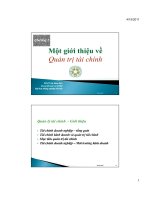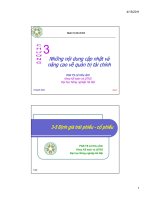ĐÁP ÁN SÁCH QUẢN TRỊ TÀI CHÍNH CUỐN TO DÀY uel KINH TE LUAT ĐÁP ÁN 6 (1)
Bạn đang xem bản rút gọn của tài liệu. Xem và tải ngay bản đầy đủ của tài liệu tại đây (128.66 KB, 11 trang )
Chapter 6
Interest Rates
Learning Objectives
After reading this chapter, students should be able to:
Explain how capital is allocated in a supply/demand framework, and list the fundamental
factors that affect the cost of money.
Write out two equations for the nominal, or quoted, interest rate, and briefly discuss each
component.
Define what is meant by the term structure of interest rates, and graph a yield curve for a
given set of data.
Explain what factors determine the shape of the yield curve.
Use the yield curve and the information embedded in it to estimate the market’s
expectations regarding future inflation and risk.
List four additional factors that influence the level of interest rates and the slope of the
yield curve.
Discuss country risk.
Briefly explain how interest rate levels affect business decisions.
Chapter 6: Interest Rates
Learning Objectives 117
Lecture Suggestions
Chapter 6 is important because it lays the groundwork for the following chapters.
Additionally, students have a curiosity about interest rates, so this chapter stimulates their
interest in the course.
What we cover, and the way we cover it, can be seen by scanning the slides and
Integrated Case solution for Chapter 6, which appears at the end of this chapter solution. For
other suggestions about the lecture, please see the “Lecture Suggestions” in Chapter 2, where
we describe how we conduct our classes.
DAYS ON CHAPTER: 1 OF 58 DAYS (50-minute periods)
118 Lecture Suggestions
Chapter 6: Interest Rates
Answers to End-of-Chapter Questions
6-1
Regional mortgage rate differentials do exist, depending on supply/demand conditions
in the different regions. However, relatively high rates in one region would attract
capital from other regions, and the end result would be a differential that was just
sufficient to cover the costs of effecting the transfer (perhaps ½ of one percentage
point). Differentials are more likely in the residential mortgage market than the
business loan market, and not at all likely for the large, nationwide firms, which will do
their borrowing in the lowest-cost money centers and thereby quickly equalize rates
for large corporate loans. Interest rates are more competitive, making it easier for
small borrowers, and borrowers in rural areas, to obtain lower cost loans.
6-2
Short-term interest rates are more volatile because (1) the Fed operates mainly in the
short-term sector, hence Federal Reserve intervention has its major effect here, and
(2) long-term interest rates reflect the average expected inflation rate over the next 20
to 30 years, and this average does not change as radically as year-to-year
expectations.
6-3
Interest rates will fall as the recession takes hold because (1) business borrowings will
decrease and (2) the Fed will increase the money supply to stimulate the economy.
Thus, it would be better to borrow short-term now, and then to convert to long-term
when rates have reached a cyclical low. Note, though, that this answer requires
interest rate forecasting, which is extremely difficult to do with better than 50%
accuracy.
6-4
a. If transfers between the two markets are costly, interest rates would be different in
the two areas. Area Y, with the relatively young population, would have less in
savings accumulation and stronger loan demand. Area O, with the relatively old
population, would have more savings accumulation and weaker loan demand as
the members of the older population have already purchased their houses and are
less consumption oriented. Thus, supply/demand equilibrium would be at a higher
rate of interest in Area Y.
b. Yes. Nationwide branching, and so forth, would reduce the cost of financial
transfers between the areas. Thus, funds would flow from Area O with excess
relative supply to Area Y with excess relative demand. This flow would increase
the interest rate in Area O and decrease the interest rate in Y until the rates were
roughly equal, the difference being the transfer cost.
6-5
A significant increase in productivity would raise the rate of return on producers’
investment, thus causing the investment curve (see Figure 6-1 in the textbook) to shift
to the right. This would increase the amount of savings and investment in the
economy, thus causing all interest rates to rise.
6-6
a. The immediate effect on the yield curve would be to lower interest rates in the
short-term end of the market, since the Fed deals primarily in that market
segment. However, people would expect higher future inflation, which would raise
long-term rates. The result would be a much steeper yield curve.
b. If the policy is maintained, the expanded money supply will result in increased
Chapter 6: Interest Rates
Integrated Case 119
rates of inflation and increased inflationary expectations. This will cause investors
to increase the inflation premium on all debt securities, and the entire yield curve
would rise; that is, all rates would be higher.
6-7
a. S&Ls would have a higher level of net income with a “normal” yield curve. In this
situation their liabilities (deposits), which are short-term, would have a lower cost
than the returns being generated by their assets (mortgages), which are long-term.
Thus, they would have a positive “spread.”
b. It depends on the situation. A sharp increase in inflation would increase interest
rates along the entire yield curve. If the increase were large, short-term interest
rates might be boosted above the long-term interest rates that prevailed prior to
the inflation increase. Then, since the bulk of the fixed-rate mortgages were
initiated when interest rates were lower, the deposits (liabilities) of the S&Ls would
cost more than the returns being provided on the assets. If this situation continued
for any length of time, the equity (reserves) of the S&Ls would be drained to the
point that only a “bailout” would prevent bankruptcy. This has indeed happened
in the United States. Thus, in this situation the S&L industry would be better off
selling their mortgages to federal agencies and collecting servicing fees rather
than holding the mortgages they originated.
6-8
Treasury bonds, along with all other bonds, are available to investors as an alternative
investment to common stocks. An increase in the return on Treasury bonds would
increase the appeal of these bonds relative to common stocks, and some investors
would sell their stocks to buy T-bonds. This would cause stock prices, in general, to
fall. Another way to view this is that a relatively riskless investment (T-bonds) has
increased its return by 4 percentage points. The return demanded on riskier
investments (stocks) would also increase, thus driving down stock prices. The exact
relationship will be discussed in Chapter 8 (with respect to risk) and Chapters 7 and 9
(with respect to price).
6-9
A trade deficit occurs when the U.S. buys more than it sells. In other words, a trade
deficit occurs when the U.S. imports more than it exports. When trade deficits occur,
they must be financed, and the main source of financing is debt. Therefore, the larger
the U.S. trade deficit, the more the U.S. must borrow, and as the U.S. increases its
borrowing, this drives up interest rates.
120 Integrated Case
Chapter 6: Interest Rates
Solutions to End-of-Chapter Problems
6-1
a.
Term
6 months
1 year
2 years
3 years
4 years
5 years
10 years
20 years
30 years
Rate
5.1%
5.5
5.6
5.7
5.8
6.0
6.1
6.5
6.3
Interest Rate
(%)
Years to Maturity
b. The yield curve shown is an upward sloping yield curve.
c. This yield curve tells us generally that either inflation is expected to increase or
there is an increasing maturity risk premium.
d. It would make sense to borrow long term because each year the loan is renewed
interest rates are higher. This exposes you to rollover risk. If you borrow for 30
years outright you have locked in a 6.3% interest rate each year.
6-2
T-bill rate
= r* + IP
5.5% = r* + 3.25%
r* = 2.25%.
6-3
r* = 3%; I1 = 2%; I2 = 4%; I3 = 4%; MRP = 0; rT2 = ?; rT3 = ?
r = r* + IP + DRP + LP + MRP.
Since these are Treasury securities, DRP = LP = 0.
rT2 = r* + IP2.
IP2 = (2% + 4%)/2 = 3%.
rT2 = 3% + 3% = 6%.
rT3 = r* + IP3.
IP3 = (2% + 4% + 4%)/3 = 3.33%.
rT3 = 3% + 3.33% = 6.33%.
6-4
rT10 = 6%; rC10 = 8%; LP = 0.5%; DRP = ?
r = r* + IP + DRP + LP + MRP.
rT10 = 6% = r* + IP10 + MRP10; DRP = LP = 0.
Chapter 6: Interest Rates
Integrated Case 121
rC10 = 8% = r* + IP10 + DRP + 0.5% + MRP10.
Because both bonds are 10-year bonds the inflation premium and maturity risk
premium on both bonds are equal. The only difference between them is the liquidity
and default risk premiums.
rC10 = 8% = r* + IP + MRP + 0.5% + DRP. But we know from above that r* + IP 10 +
MRP10 = 6%; therefore,
rC10 = 8% = 6% + 0.5% + DRP
1.5% = DRP.
6-5
r* = 3%; IP2 = 3%; rT2 = 6.2%; MRP2 = ?
rT2 = r* + IP2 + MRP2 = 6.2%
rT2 = 3% + 3% + MRP2 = 6.2%
MRP2 = 0.2%.
6-6
r* = 5%; I1-4 = 16%; MRP = DRP = LP = 0; r4 = ?
r4 = rRF.
rRF = (1 + r*)(1 + I) – 1
= (1.05)(1.16) – 1
= 0.218 = 21.8%.
6-7
rT1 = 5%; 1rT1 = 6%; rT2 = ?
(1 + rT2)2
= (1.05)(1.06)
(1 + rT2)2
= 1.113
1 + rT2 = 1.055
rT2 = 5.5%.
6-8
Let X equal the yield on 2-year securities 4 years from now:
(1.07) 4(1 + X)2 = (1.075) 6
(1.3108)(1 + X)2
= 1.5433
1.5433
1+X =
1.3108
X = 8.5%.
6-9
1/ 2
r = r* + IP + MRP + DRP + LP.
r* = 0.03.
IP = [0.03 + 0.04 + (5)(0.035)]/7 = 0.035.
MRP = 0.0005(6) = 0.003.
DRP = 0.
LP = 0.
rT7 = 0.03 + 0.035 + 0.003 = 0.068 = 6.8%.
122 Integrated Case
Chapter 6: Interest Rates
6-10
Basic relevant equations:
rt = r* + IPt + DRPt + MRPt + IPt.
But here IPt is the only premium, so rt = r* + IPt.
IPt = Avg. inflation = (I1 + I2 + . . .)/N.
We know that I1 = IP1 = 3% and r* = 2%. Therefore,
rT1 = 2% + 3% = 5%. rT3 = rT1 + 2% = 5% + 2% = 7%. But,
rT3 = r* + IP3 = 2% + IP3 = 7%, so
IP3 = 7% – 2% = 5%.
We also know that It = Constant after t = 1.
We can set up this table:
1
2
3
r*
2%
2%
2%
I
3%
I
I
Avg. I = IPt
3%/1 = 3%
(3% + I)/2 = IP2
(3% + I + I)/3 = IP3
r = r* + IPt
5%
r3 = 7%, so IP3 = 7% – 2% = 5%.
IP3 = (3% + 2I)/3 = 5%
2I = 12%
I = 6%.
6-11
We’re given all the components to determine the yield on the bonds except the default
risk premium (DRP) and MRP. Calculate the MRP as 0.1%(5 – 1) = 0.4%. Now, we can
solve for the DRP as follows:
7.75% = 2.3% + 2.5% + 0.4% + 1.0% + DRP, or DRP = 1.55%.
6-12
First, calculate the inflation premiums for the next three and five years, respectively.
They are IP3 = (2.5% + 3.2% + 3.6%)/3 = 3.1% and IP 5 = (2.5% + 3.2% + 3.6% + 3.6%
+ 3.6%)/5 = 3.3%. The real risk-free rate is given as 2.75%. Since the default and
liquidity premiums are zero on Treasury bonds, we can now solve for the maturity risk
premium. Thus, 6.25% = 2.75% + 3.1% + MRP 3, or MRP3 = 0.4%. Similarly, 6.8% =
2.75% + 3.3% + MRP5, or MRP5 = 0.75%. Thus, MRP5 – MRP3 = 0.75% – 0.40% =
0.35%.
6-13
rC8 = r* + IP8 + MRP8 + DRP8 + LP8
8.3% = 2.5% + (2.8% 4 + 3.75% 4)/8 + 0.0% + DRP8 + 0.75%
8.3% = 2.5% + 3.275% + 0.0% + DRP8 + 0.75%
8.3% = 6.525% + DRP8
DRP8 = 1.775%.
Chapter 6: Interest Rates
Integrated Case 123
6-14
a.
(1.045) 2 = (1.03)(1 + X)
1.092/1.03= 1 + X
X = 6%.
b. For riskless bonds under the expectations theory, the interest rate for a bond of
any
maturity
is
rN = r* + average inflation over N years. If r* = 1%, we can solve for IPN:
Year 1:
r1 = 1% + I1 = 3%;
I1 = expected inflation = 3% – 1% = 2%.
Year 2:
r1 = 1% + I2 = 6%;
I2 = expected inflation = 6% – 1% = 5%.
Note also that the average inflation rate is (2% + 5%)/2 = 3.5%, which, when
added to r* = 1%, produces the yield on a 2-year bond, 4.5%. Therefore, all of our
results are consistent.
6-15
r* = 2%; MRP = 0%; r1 = 5%; r2 = 7%; X = ?
X represents the one-year rate on a bond one year from now (Year 2).
(1.07) 2 = (1.05)(1 + X)
1.1449
=1+X
1.05
X = 9%.
9% = r* + I2
9% = 2% + I2
7% = I2.
The average interest rate during the 2-year period differs from the 1-year interest rate
expected for Year 2 because of the inflation rate reflected in the two interest rates.
The inflation rate reflected in the interest rate on any security is the average rate of
inflation expected over the security’s life.
6-16
rRF = r6 = 20.84%; MRP = DRP = LP = 0; r* = 6%; I = ?
20.84%
1.2084
1.14
0.14
6-17
= (1.06)(1 + I) – 1
= (1.06)(1 + I)
=1+I
= I.
rT5 = 5.2%; r T10 = 6.4%; r C10 = 8.4%; IP10 = 2.5%; MRP = 0. For Treasury securities, DRP
= LP = 0.
DRP5 + LP5 = DRP10 + LP10. rC5 = ?
rT10 = r* + IP10
6.4% = r* + 2.5%
124 Integrated Case
Chapter 6: Interest Rates
r* = 3.9%.
rT5 = r* + IP5
5.2% = 3.9% + IP5
1.3% = IP5.
rC10 = r* + IP10 + DRP10 + LP10
8.4% = 3.9% + 2.5% + DRP10 + LP10
2% = DRP10 + LP10.
rC5 = 3.9% + 1.3% + DRP5 + LP5, but DRP5 + LP5 = DRP10 + LP10 = 2%. So,
rC5 = 3.9% + 1.3% + 2%
= 7.2%.
6-18
a. Years to
Maturity
1
2
3
4
5
10
20
Real Risk-Free
Rate (r*)
2%
2
2
2
2
2
2
IP**
7.00%
6.00
5.00
4.50
4.20
3.60
3.30
MRP
0.2%
0.4
0.6
0.8
1.0
1.0
1.0
rT = r* + IP + MRP
9.20%
8.40
7.60
7.30
7.20
6.60
6.30
**The computation of the inflation premium is as follows:
Expected
Inflation
7%
5
3
3
3
3
3
Year
1
2
3
4
5
10
20
Average
Expected Inflation
7.00%
6.00
5.00
4.50
4.20
3.60
3.30
For example, the calculation for 3 years is as follows:
7% 5% 3%
3
= 5.00%.
Thus, the yield curve would be as follows:
Interest
Rate (%)
11.0
10.5
10.0
9.5
9.0
8.5
Exelon
8.0
7.5
7.0
ExxonMobil
6.5
T-bonds
0
2
Chapter 6: Interest Rates
4
6
8
10
12
14
16
18
Years to
Maturit
20
y
Integrated Case 125
b. The interest rate on the ExxonMobil bonds has the same components as the Treasury
securities, except that the ExxonMobil bonds have default risk, so a default risk
premium must be included. Therefore,
rExxonMobil = r* + IP + MRP + DRP.
For a strong company such as ExxonMobil, the default risk premium is virtually
zero for short-term bonds. However, as time to maturity increases, the probability
of default, although still small, is sufficient to warrant a default premium. Thus,
the yield risk curve for the ExxonMobil bonds will rise above the yield curve for the
Treasury securities. In the graph, the default risk premium was assumed to be 1.0
percentage point on the 20-year ExxonMobil bonds. The return should equal 6.3%
+ 1% = 7.3%.
c. Exelon bonds would have significantly more default risk than either Treasury
securities or ExxonMobil bonds, and the risk of default would increase over time
due to possible financial deterioration. In this example, the default risk premium
was assumed to be 1.0 percentage point on the 1-year Exelon bonds and 2.0
percentage points on the 20-year bonds. The 20-year return should equal 6.3% +
2% = 8.3%.
6-19
a. The average rate of inflation for the 5-year period is calculated as:
Average
= (0.13 + 0.09 + 0.07 + 0.06 + 0.06)/5 = 8.20%.
inflationrate
b. r = r* + IPAvg. = 2% + 8.2% = 10.20%.
c. Here is the general situation:
Yea
r
1
2
3
5
1-Year Expected
Inflation
.
.
.
10
20
126 Integrated Case
13%
9
7
6
.
.
.
6
6
Arithmetic
Average Expected
Inflation
13.0%
11.0
9.7
8.2
.
.
.
7.1
6.6
r*
2%
2
2
2
.
.
.
2
2
Maturity
Risk
Premium
0.1%
0.2
0.3
0.5
Estimated
Interest Rates
1.0
2.0
10.1
10.6
.
.
.
15.1%
13.2
12.0
10.7
.
.
.
Chapter 6: Interest Rates
Interest Rate
(%)
15.0
12.5
10.0
7.5
5.0
2.5
0
2
4
6
8
10
12
14 16 18 20
Years to Maturity
d. The “normal” yield curve is upward sloping because, in “normal” times, inflation is
not expected to trend either up or down, so IP is the same for debt of all maturities,
but the MRP increases with years, so the yield curve slopes up. During a recession,
the yield curve typically slopes up especially steeply, because inflation and
consequently short-term interest rates are currently low, yet people expect
inflation and interest rates to rise as the economy comes out of the recession.
e. If inflation rates are expected to be constant, then the expectations theory holds that
the yield curve should be horizontal. However, in this event it is likely that maturity
risk premiums would be applied to long-term bonds because of the greater risks of
holding long-term rather than short-term bonds:
Percent
(%)
Actual yield curve
Maturity
risk
premium
Pure expectations yield curve
Years to Maturity
If maturity risk premiums were added to the yield curve in Part e above, then the
yield curve would be more nearly normal; that is, the long-term end of the curve
would be raised. (The yield curve shown in this answer is upward sloping; the
yield curve shown in part c is downward sloping.)
Chapter 6: Interest Rates
Integrated Case 127









